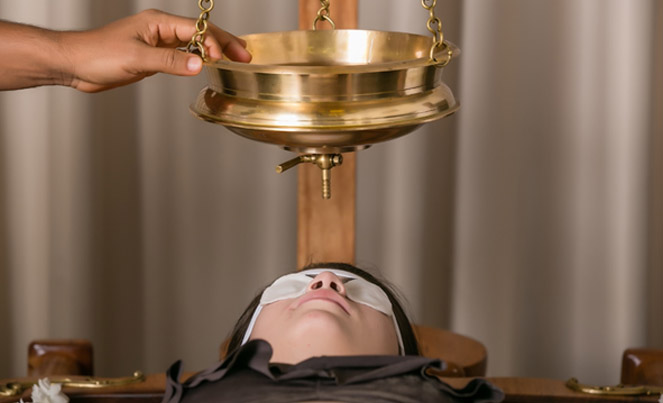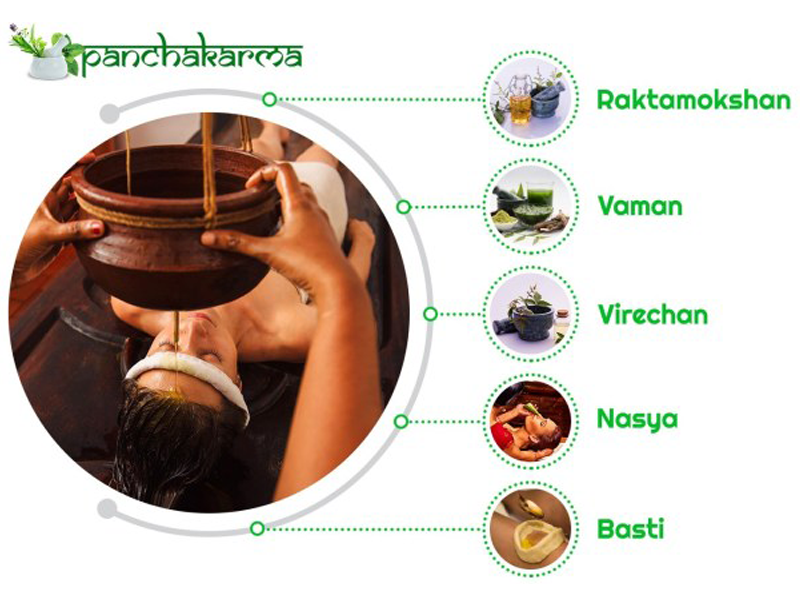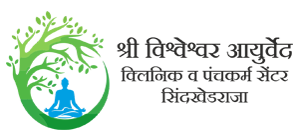
Panchakarma Process
Three-steps of Panchakarma process:
Panchakarma is practiced in three carefully dilenated stages: these methods use a variety of herbs, oils, and other substances to safely and comfortably flush toxins and impurities from the body, to help clear the nasal passages, purge the stomach, cleanse the bowels and provide nourishment to the body tissues.
- Purvakarma(The preparation stage)
- Pradhanakarma (The cleansing stage)
- Paschata karma (The rejuvenation stage)
- Purva karma (The preparation stage):
It is a set of preparatory therapies applied, to facilitate the removal of toxins from body tissues and drain them to the alimentary canal before the actual purification begins.
These treatments are directed to preparing the patient mentally and physically for the main procedure.
- Deepana and Pachankarma : To improve digestion with intake of digestive herbs, warm water and fasting, so that patient can digest the Ghee properly, which is given to liquefy the fat soluble toxins. Also helpful to stimulate the metabolism, improve the blood circulation and enhance the mental concentration.
- Snehan karma : (Oleation therapy)It is carried out in two ways:
- AbhyantarSnehana (Internal oleation) : It is done by administering small quantities of medicated oil or ghee orally. The duration of internal oleation, quantity and type of medicated oil or ghee is determined by the physician after analyzing the body constitution of the patient. The patient is advised to eat liquid food or light food on the day prior to internal oleation. After consuming the medicated oil or ghee the patient is encouraged to sip warm water frequently. When medicated oil or ghee is completely digested, the patient is advised to consume light food. The oleation therapy safeguards the healthy tissues of the body, loosens toxins within the system, and flushes the skin’s pores.
- Bahyasnehana (External oleation) : It is is done after the completion of internal oleation. Oil is applied to the skin by a variety of massage techniques (Abhyanga).
- Swedan karma(Fomentation) :Soon after oil massage the patient is exposed to heat through steam bath or other heating methods which include the use of vapour and steam baths (Bashpasweda), saunas, hot poultices (Pottalisweda), hot showers and baths. This helps to open up the body channels and liquefy the toxins even more which facilitates their movement from the tissues to the digestive tract.Swedana relieves stiffness, heaviness, and pain in the body.
Pradhana karma (The cleansing stage):
After the three steps of Purvakarma are completed, the Pradhankarma commences. These procedures are very typically performed & always need a well-trained Ayurvedic Physician who could assess all the things. However, every patient may not need to undergo each of the procedures listed here.
- VAMANA(Emesis Therapy)
All Department
Opening Hours
| Monday – Saturday | 9.00 am – 9.00 pm |
| Sunday | Closed |
Book Appointment

Pre-procedure:
Medicated ghee or oil is given orally, in such a quantity, that will require at least 12 hours to get digested. The steam bath is also given simultaneously once or twice a day.
Main- Procedure:
The procedure is done during kapha kala i.e early in the morning from 6 a.m. to 9.30 a.m. The patient is asked to drink herbal decoction along with milk or sugarcane juice or alone till the stomach is totally filled and the patient is unable to take more. Vomiting generally starts automatically and then the process of drinking and vomiting continues till the wholeKapha is expelled out.
Post- procedure:
The person is advised to take rest. Dhumpan (Herbal cigarettes) are given for inhalation after completion of the process. SansarjanKrama(graduated diet) is strictly advised. The diet is given in a particular order starting from rice water (rice + 14 times water to be cooked and filtered) to normal food. It may take 3 to 10 days depending on the elimination doshas to come back to normal diet.
Indications:
Bronchial asthma, chronic cough,sinusitis, chronic allergies, psoriasis, urticaria, arthritis, diabetes, obesity, thyroid disorders, goitre, tumours, fibroids, hyperacidity, indigestion, anorexia, epilepsy, acne and other skin diseases.
- VIRECHANA (Purgation Therapy)
Pre-Procedure :
Prior to the Virechana procedure, the patient is subjected to snehana(oleation) and swedanafomentation. The internal oleation is done for three to seven days followed by a medicated steam bath performed for three days.
Main Procedure:
The medicine is usually administered on empty stomach very early in the morning, or during pitta time when pitta-related ama naturally accumulates in the pitta regions. After ingesting the purgative, there follows a series of three to fifteen loose bowel movements a few hours later. The patient is asked to take sips of warm water, have fomentation to abdomen with hot water bag or heating pad to stimulate the digestive tract. The number of movements varies depending on the patients Ayurvedic constitution and the amount of ama present in the pitta region of the body. When the Pitta gets eliminated and Kapha in the form of mucus starts coming out the procedure is stopped.
Post Procedure:
After the procedure of Virechana karma, the Samsarjana Karma (graduated diet) are followed for a period of 3 to 7 days. This consists of starting with Manda (rice water), the Peya(thick rice water), then Vilepi (thicker rice water) and finally AkritaYusha and KritaYusha (vegetable soup). This entire process is followed upto 3 to 7 daysor until full digestive strength returns. It is very important at this stage not to eat or drink anything cold as this will shrink the bodily channels, aggravate vata and tax an already weakened digestive fire.
Indications:
Joint disorders like rheumatic arthritis, gout, gynaecological disorders, chronic fever, headaches, asthma, psoriasis, urticaria, eczema, acne, obesity, diabetes, gastritis, constipation, irritable bowel syndrome, spleen disorders, jaundice, gall stones, dysuria, urinary tract disorders.
- BASTI(Oil And Decoction Enema)
Types of Basti:
Depending on the type of liquid medicine used:
- AnuvasanaBasti (Oil based enema):
- Niruha – AsthapanBasti (Decoction based enema):
Eight most popular Basti:
- Anuvasana(oil enema): It is used in pure Vata disorders and when a person is having excess hunger or dryness related to Vata imbalances.
- NiruhaorAsthapana(decoction enema): It is used in other conditions, such as nervous diseases, gastro-intestinal Vata conditions, gout, certain fever conditions, unconsciousness, certain urinary conditions, appetite, pain, hyperacidity and heart diseases.
- UttarBasti (through the urethra with men or vagina with women): It is used for selected semen and ovulation disorders and for some problems involving painful urination or bladder infections.
- MatraBasti (daily oil enema): It is used by someone emaciated by overwork or too much exercise, too much heavy lifting, walking too long a distance, too much sexual activity or someone with chronic vata disorders. It does not need to be accompanied by any strict dietary restriction or daily routine and can be administered, in the appropriate cases, in all seasons. It gives strength and promotes health.
- Karma Basti (schedule of 30 bastis)
- Kala Basti (schedule of 15 bastis; 10 oil + 5 decoction)
- Yoga Basti (schedule of 8 bastis; 5 oil + 3 decoction)
- BruhanaBasti (nutritional enema): It is used for providing deep nutrition in select conditions. Traditionally, highly nutritive substances have been used, such as warm milk, meat broth, bone marrow soup and herbs like Shatavari, Vidari, Ashwagandha etc.
Post Procedure :
The person is advised to take warm water bath and then a light meal, preferably with rice. Then again the SnehaBasti can be given on the same day or the second day.
Indications:
Digestive issues, constipation, piles, colitis, irritable bowel syndrome, chronic fever, kidney stones, backache, joint pains, rheumatic arthritis, gout, osteoporosis, sciatica, muscle spasms, muscular dystrophy, hemiplegia, paraplegia, parkinson’s disease, obesity, PCOD, infertility, sexual debility.
- NASYA(Nasal administration)
Pre-Procedure :
Prior to the administration of medicine face, shoulders and chest are massaged with specific herbal oil and steam inhalation is done to open up the channels. Then the patient is asked to lie down with little head low position.
Main Procedure :
Warm medication is instilled in each nostril and the person is asked to inhale deep into the head. He is asked to spit it out, if it comes in the mouth.
Post Procedure :
Gentle massage with oil is given on the back of the neck, shoulders. Exposure to the cool air is to be avoided.
Indications:
Sinusitis, headache, migraine, cervical spondolysis, Bell’s palsy, paralysis, frozen shoulder, neck stiffness, pigmentation, pre-mature graying of hair, hair fall, nasal allergies, memory loss, epilepsy, stress, insomnia.
- RAKTAMOKSHAN (Bloodletting)
Pre-Procedure :
Snehana and swedanamay be done for 3 days or more as per requirements. The patient is advised to take some food which will aggravate the dosha little bit e.g. curds (Yogurt) preparations from black grams, buttermilk etc.
Main Procedure :
Before starting RaktaMokshan, local fomentation is given. After that, leeches are applied at the desired site of blood letting. (Some times, it is simply extracted out through syringe and needle.) When the procedure is carried out properly, the leeches leave the site naturally after sucking out all the impure blood, and bleeding ceases spontaneously. There is significant decrease in the symptoms of pain, and inflammation, the severity of the disease is minimized.
Post Procedure :
After completion of the process of RaktaMokshan, turmeric powder is applied on the site of bloodletting. This acts as haemostatic, antiseptic and blood purifier.Very light diet is advised on the day of the procedure.
Benefits :Skin diseases like leukoderma, psoriasis, acne, urticaria and leprosy, jaundice, herpes zoster, varicose veins, sciatica, trigeminal neuralgia, migraine, disorders of liver and spleenand in cases of stagnant blood causing local inflammation etc.
Paschat karma (The rejuvenation stage)
Paschat karma means after care. In this certain precautions are taken after finishing the main procedures to get the full benefit of Panchakarma therapies. It includes certain rejuvenating treatments viz. Rasayana Therapy, lifestyle management, diet management, intake of herbal supplements etc. This includes following procedures:
- Sansarjankrama (Graduated food therapy after cleansing and detoxification)
- RasayanChikitsa (The rejuvenating Rasayan Therapy)
- Shaman Chikitsa ( The Pacification therapy with Herbs and life style management)

